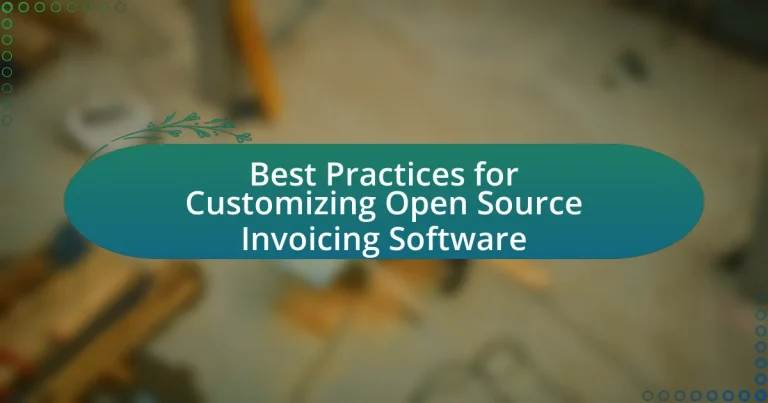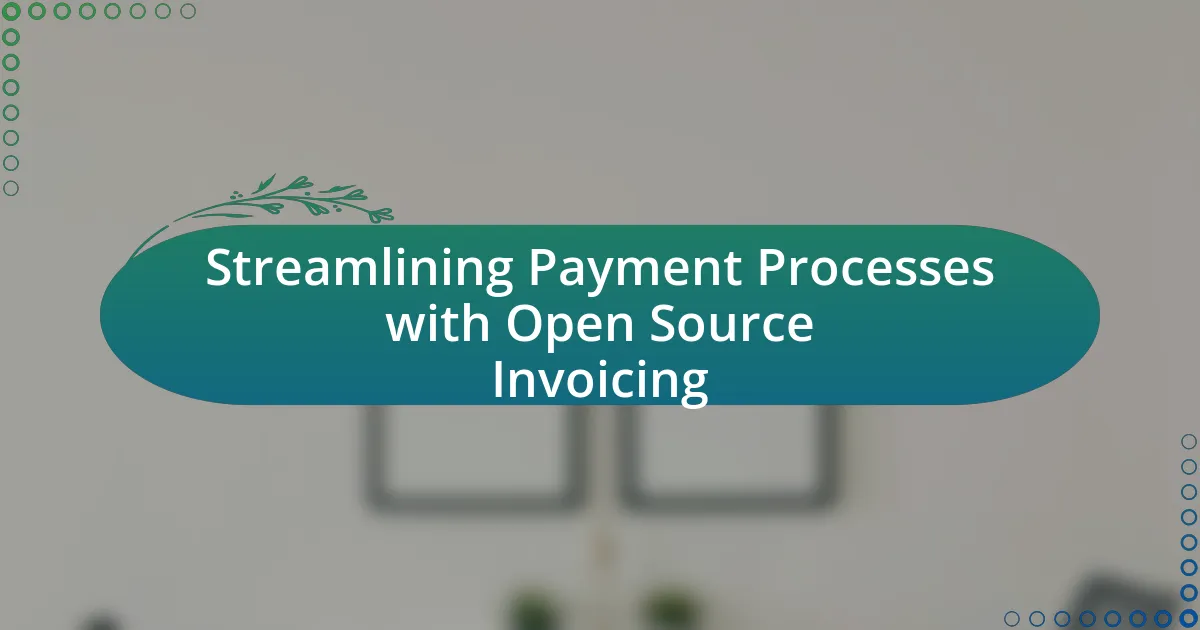The article focuses on best practices for customizing open source invoicing software, emphasizing the importance of understanding software architecture, maintaining clear documentation, and ensuring compliance with legal standards. It discusses how understanding user needs can enhance customization efforts and outlines effective methods for gathering user feedback, such as surveys and usability testing. Key features for customization, essential functionalities for businesses, and the significance of maintaining software updates are also covered. Additionally, the article addresses challenges in customization, security considerations, and best practices for testing customized software, providing a comprehensive guide for developers seeking to optimize open source invoicing solutions.

What are the best practices for customizing open source invoicing software?
The best practices for customizing open source invoicing software include understanding the software’s architecture, maintaining clear documentation, and ensuring compliance with legal standards. Understanding the architecture allows developers to make informed modifications without disrupting core functionalities. Clear documentation is essential for tracking changes and facilitating future updates or troubleshooting. Compliance with legal standards, such as data protection regulations, ensures that the software remains secure and trustworthy for users. These practices are supported by the fact that many successful open source projects emphasize the importance of documentation and compliance to foster community trust and collaboration.
How can understanding user needs improve customization efforts?
Understanding user needs enhances customization efforts by ensuring that the modifications made to open source invoicing software align closely with the specific requirements and preferences of the users. When developers gather insights into user behaviors, pain points, and desired features, they can tailor the software to address these aspects effectively. For instance, a study by Nielsen Norman Group highlights that user-centered design increases user satisfaction by 20-30%, demonstrating that customization based on user needs leads to more effective and relevant solutions. This alignment not only improves user experience but also increases the likelihood of software adoption and long-term engagement.
What methods can be used to gather user feedback effectively?
Surveys and questionnaires are effective methods for gathering user feedback. These tools allow for structured data collection, enabling users to provide insights on their experiences and preferences. According to a study by SurveyMonkey, 70% of users prefer surveys for providing feedback, as they can be completed at the user’s convenience and can cover a wide range of topics. Additionally, interviews and focus groups facilitate in-depth discussions, allowing for qualitative insights that surveys may not capture. Research from the Nielsen Norman Group indicates that direct user interviews can uncover usability issues that users might not articulate in written feedback. Furthermore, usability testing provides real-time feedback as users interact with the software, revealing pain points and areas for improvement. A report by the User Experience Professionals Association highlights that usability testing can lead to a 50% reduction in user errors when implemented effectively.
How does user feedback influence software customization?
User feedback significantly influences software customization by providing developers with insights into user needs and preferences. This feedback allows developers to identify specific features that users find valuable or problematic, leading to targeted enhancements. For instance, a study by the Nielsen Norman Group found that user feedback can improve usability by up to 50%, demonstrating its critical role in refining software functionalities. By integrating user suggestions and addressing pain points, developers can create a more tailored and effective invoicing software solution that meets the actual demands of its users.
What are the key features to consider when customizing invoicing software?
Key features to consider when customizing invoicing software include user interface design, integration capabilities, automation options, reporting and analytics, and compliance with tax regulations. User interface design ensures ease of use, which is critical for user adoption. Integration capabilities allow the software to connect with other systems, such as accounting or CRM tools, enhancing workflow efficiency. Automation options streamline repetitive tasks, reducing manual errors and saving time. Reporting and analytics provide insights into financial performance, enabling informed decision-making. Compliance with tax regulations ensures that the invoicing process adheres to legal requirements, minimizing the risk of penalties. These features collectively enhance the functionality and effectiveness of customized invoicing software.
Which invoicing functionalities are essential for businesses?
Essential invoicing functionalities for businesses include automated billing, customizable invoice templates, multi-currency support, and integration with accounting software. Automated billing streamlines the invoicing process, reducing manual errors and saving time. Customizable invoice templates allow businesses to maintain brand consistency and present professional invoices. Multi-currency support is crucial for businesses operating internationally, enabling them to invoice clients in their preferred currency. Integration with accounting software ensures accurate financial tracking and reporting, facilitating better cash flow management. These functionalities enhance efficiency and accuracy in financial operations, which are vital for business success.
How can customization enhance these essential functionalities?
Customization can enhance essential functionalities of open source invoicing software by tailoring features to meet specific business needs. This adaptability allows organizations to streamline processes, improve user experience, and integrate seamlessly with existing systems. For instance, businesses can modify invoicing templates to reflect their branding, which can lead to increased customer recognition and trust. Additionally, customization enables the incorporation of unique reporting metrics that align with specific business goals, thereby providing more relevant insights. According to a study by the Journal of Software Engineering, tailored software solutions can increase productivity by up to 30%, demonstrating the tangible benefits of customization in enhancing core functionalities.
Why is it important to maintain software updates during customization?
Maintaining software updates during customization is crucial to ensure security, functionality, and compatibility. Regular updates often include patches for vulnerabilities, which protect the software from potential threats. For instance, a study by the Ponemon Institute found that 60% of data breaches are linked to unpatched vulnerabilities. Additionally, updates can introduce new features and improvements that enhance the user experience and maintain compatibility with other systems. Therefore, neglecting updates during customization can lead to security risks and operational inefficiencies.
What challenges arise from customizing open source software?
Customizing open source software presents several challenges, including compatibility issues, lack of documentation, and potential security vulnerabilities. Compatibility issues arise when customizations conflict with existing code or updates from the original software, leading to functionality problems. The lack of comprehensive documentation can hinder developers’ understanding of the software’s architecture, making it difficult to implement effective customizations. Additionally, custom modifications may introduce security vulnerabilities if not properly managed, as they can bypass established security protocols. These challenges necessitate careful planning and testing to ensure successful customization of open source software.
How can developers ensure compatibility with future updates?
Developers can ensure compatibility with future updates by adhering to established coding standards and utilizing version control systems. By following coding standards, developers create code that is easier to read and maintain, which facilitates updates. Version control systems, such as Git, allow developers to track changes and manage different versions of the software, making it simpler to integrate updates without losing previous functionality. Additionally, regularly reviewing and testing the software against the latest updates from the open-source community helps identify potential compatibility issues early. This proactive approach minimizes disruptions and ensures that the software remains functional with each new release.

How can developers effectively implement customization in open source invoicing software?
Developers can effectively implement customization in open source invoicing software by leveraging modular architecture and utilizing existing APIs. Modular architecture allows developers to create separate components that can be independently modified or replaced, facilitating easier updates and custom features. Utilizing APIs enables integration with other systems and services, enhancing functionality without altering the core software. For instance, many open source invoicing platforms, such as Invoice Ninja, provide extensive documentation and community support, which can guide developers in implementing specific customizations efficiently. This approach not only streamlines the customization process but also ensures that the software remains maintainable and scalable over time.
What programming languages and tools are commonly used for customization?
Commonly used programming languages for customization include JavaScript, Python, PHP, and Ruby. These languages are favored due to their versatility and widespread support in open source projects. JavaScript is often utilized for front-end customization, enabling dynamic user interfaces. Python is popular for back-end development and scripting, providing robust libraries for data manipulation. PHP is frequently used in web development, particularly for server-side scripting in applications like invoicing software. Ruby, known for its elegant syntax, is commonly employed in web frameworks such as Ruby on Rails, facilitating rapid development. Tools that support customization include Git for version control, Docker for containerization, and various IDEs like Visual Studio Code and PyCharm, which enhance the development experience. These languages and tools collectively empower developers to tailor open source invoicing software to meet specific business needs.
How do different programming languages impact the customization process?
Different programming languages significantly impact the customization process by influencing the ease of modification, available libraries, and community support. For instance, languages like Python and JavaScript offer extensive libraries and frameworks that simplify the customization of open-source software, enabling developers to implement features quickly. In contrast, languages such as C++ may require more complex coding and a deeper understanding of system architecture, which can slow down the customization process. Furthermore, the community surrounding a programming language can provide valuable resources and support; for example, Python has a large community that contributes to a wealth of documentation and third-party modules, facilitating easier customization. Thus, the choice of programming language directly affects the efficiency and effectiveness of the customization process in open-source invoicing software.
What tools can facilitate the customization of invoicing software?
Tools that can facilitate the customization of invoicing software include application programming interfaces (APIs), software development kits (SDKs), and customizable templates. APIs allow developers to integrate invoicing software with other applications, enabling tailored functionalities. SDKs provide libraries and tools that simplify the development process, allowing for specific feature enhancements. Customizable templates enable users to modify the appearance and layout of invoices easily, ensuring alignment with branding requirements. These tools collectively enhance the flexibility and adaptability of invoicing software, making it more suited to individual business needs.
What role does documentation play in the customization process?
Documentation serves as a critical resource in the customization process by providing clear guidelines and instructions for modifying open source invoicing software. It ensures that developers understand the software’s architecture, functionality, and available customization options, which facilitates efficient and effective modifications. Comprehensive documentation often includes examples, code snippets, and best practices, enabling users to implement changes without introducing errors. Furthermore, well-maintained documentation can reduce the learning curve for new developers and enhance collaboration among team members, ultimately leading to a more streamlined customization process.
How can comprehensive documentation improve user experience?
Comprehensive documentation significantly improves user experience by providing clear, detailed guidance on software features and functionalities. When users have access to well-structured documentation, they can quickly understand how to utilize the software effectively, reducing frustration and enhancing satisfaction. Research indicates that 70% of users prefer self-service options, such as documentation, for troubleshooting and learning, which underscores the importance of comprehensive resources in facilitating user independence and confidence.
What types of documentation are essential for successful customization?
Essential documentation for successful customization includes user manuals, API documentation, and code comments. User manuals provide guidance on how to navigate and utilize the software effectively, ensuring that users understand its features and functionalities. API documentation is crucial for developers, as it outlines how to interact with the software programmatically, detailing endpoints, request formats, and response structures. Code comments serve as in-line documentation that explains the logic and purpose of specific code segments, facilitating easier modifications and maintenance. Collectively, these types of documentation enhance the customization process by providing clear instructions and insights, ultimately leading to more efficient and effective software adaptations.

What are the common pitfalls to avoid when customizing open source invoicing software?
Common pitfalls to avoid when customizing open source invoicing software include neglecting documentation, failing to adhere to coding standards, and overlooking security vulnerabilities. Neglecting documentation can lead to difficulties in maintaining and updating the software, as future developers may struggle to understand the customizations made. Failing to adhere to coding standards can result in code that is difficult to read and maintain, increasing the risk of bugs and compatibility issues. Overlooking security vulnerabilities can expose sensitive financial data to risks, as custom code may not undergo the same rigorous security testing as the original software. These pitfalls can significantly hinder the effectiveness and longevity of the customized invoicing solution.
How can over-customization negatively impact software performance?
Over-customization can negatively impact software performance by introducing excessive complexity and increasing resource consumption. When software is overly customized, it often leads to bloated code, which can slow down execution times and increase memory usage. For instance, a study by the Software Engineering Institute found that software systems with high levels of customization can experience performance degradation of up to 30% due to inefficient code paths and increased load times. Additionally, over-customization can complicate maintenance and updates, as custom features may not be compatible with new versions of the software, further hindering performance.
What signs indicate that customization is becoming excessive?
Signs that customization is becoming excessive include a significant increase in maintenance costs, a decline in system performance, and user confusion due to overly complex interfaces. When maintenance costs rise, it often indicates that the customizations require more resources to manage and update, which can strain budgets. A decline in system performance may manifest as slower processing times or frequent errors, suggesting that the added features are overloading the system. User confusion arises when the interface becomes cluttered with too many options, leading to decreased usability and user satisfaction. These indicators collectively suggest that the level of customization has surpassed practical limits, necessitating a reassessment of the approach taken.
How can developers strike a balance between customization and usability?
Developers can strike a balance between customization and usability by implementing user-centered design principles while allowing for flexible configuration options. User-centered design focuses on understanding the needs and preferences of end-users, ensuring that the software remains intuitive and accessible. For instance, usability testing can reveal how users interact with customizable features, guiding developers to prioritize essential functionalities that enhance user experience without overwhelming them. Research indicates that software with a clear, user-friendly interface can lead to a 50% increase in user satisfaction, demonstrating the importance of usability in customized solutions.
What security considerations should be taken into account during customization?
During customization of open source invoicing software, it is crucial to consider security vulnerabilities that may arise from code modifications. Customizations can introduce risks such as SQL injection, cross-site scripting (XSS), and insecure data storage if not properly managed. For instance, a study by the Open Web Application Security Project (OWASP) highlights that 70% of web applications are susceptible to SQL injection attacks due to improper input validation. Therefore, implementing secure coding practices, conducting regular security audits, and ensuring that third-party libraries are up-to-date are essential steps to mitigate these risks. Additionally, employing role-based access controls can prevent unauthorized access to sensitive financial data, further enhancing the security posture during the customization process.
How can vulnerabilities be introduced through customization?
Vulnerabilities can be introduced through customization when developers modify open source invoicing software without adhering to security best practices. Customization often involves altering code, which can inadvertently create security gaps if the changes are not properly reviewed or tested. For instance, adding new features may introduce unvalidated input fields, leading to SQL injection or cross-site scripting attacks. According to a study by the Open Web Application Security Project (OWASP), 70% of web applications have vulnerabilities due to improper input validation during customization. This highlights the importance of following secure coding guidelines and conducting thorough testing to mitigate risks associated with customization.
What best practices can enhance security in customized software?
Implementing secure coding practices is essential to enhance security in customized software. This includes validating input to prevent injection attacks, using parameterized queries for database access, and employing proper authentication and authorization mechanisms. According to the OWASP Top Ten, which outlines the most critical security risks to web applications, failure to implement these practices can lead to vulnerabilities such as SQL injection and cross-site scripting, which are prevalent in customized software. Regularly updating software dependencies and conducting security audits further strengthen the security posture, as outdated libraries can introduce known vulnerabilities.
What are the best practices for testing customized invoicing software?
The best practices for testing customized invoicing software include thorough functional testing, performance testing, security testing, and user acceptance testing. Functional testing ensures that all features, such as invoice generation, payment processing, and reporting, work as intended. Performance testing assesses the software’s responsiveness and stability under various load conditions, which is crucial for handling peak usage times. Security testing identifies vulnerabilities that could expose sensitive financial data, ensuring compliance with standards like PCI DSS. User acceptance testing involves real users validating the software against their requirements, confirming that it meets business needs. These practices are essential for delivering reliable and secure invoicing solutions, as evidenced by industry standards that emphasize the importance of comprehensive testing in software development.
How can developers ensure thorough testing of custom features?
Developers can ensure thorough testing of custom features by implementing a comprehensive testing strategy that includes unit testing, integration testing, and user acceptance testing. Unit testing allows developers to validate individual components of the software, ensuring that each part functions correctly in isolation. Integration testing checks the interactions between different components, confirming that they work together as intended. User acceptance testing involves real users testing the software to ensure it meets their needs and expectations. According to a study by the National Institute of Standards and Technology, effective testing can reduce software maintenance costs by up to 40%, highlighting the importance of a structured testing approach in software development.
What tools and methodologies are recommended for effective testing?
Recommended tools for effective testing include Selenium for automated web application testing, JUnit for unit testing in Java applications, and Postman for API testing. Methodologies such as Agile testing, which emphasizes iterative development and continuous feedback, and Test-Driven Development (TDD), which focuses on writing tests before code, are also effective. These tools and methodologies enhance testing efficiency and accuracy, ensuring that software meets quality standards.
What tips can help streamline the customization process for open source invoicing software?
To streamline the customization process for open source invoicing software, prioritize clear documentation and modular design. Clear documentation provides essential guidance on the software’s architecture and customization options, enabling developers to make informed changes efficiently. Modular design allows for isolated adjustments, reducing the risk of affecting other components and simplifying troubleshooting. Additionally, leveraging community forums and existing plugins can accelerate the customization process by providing pre-built solutions and shared knowledge. These practices enhance efficiency and reduce development time, ultimately leading to a more tailored invoicing solution.



